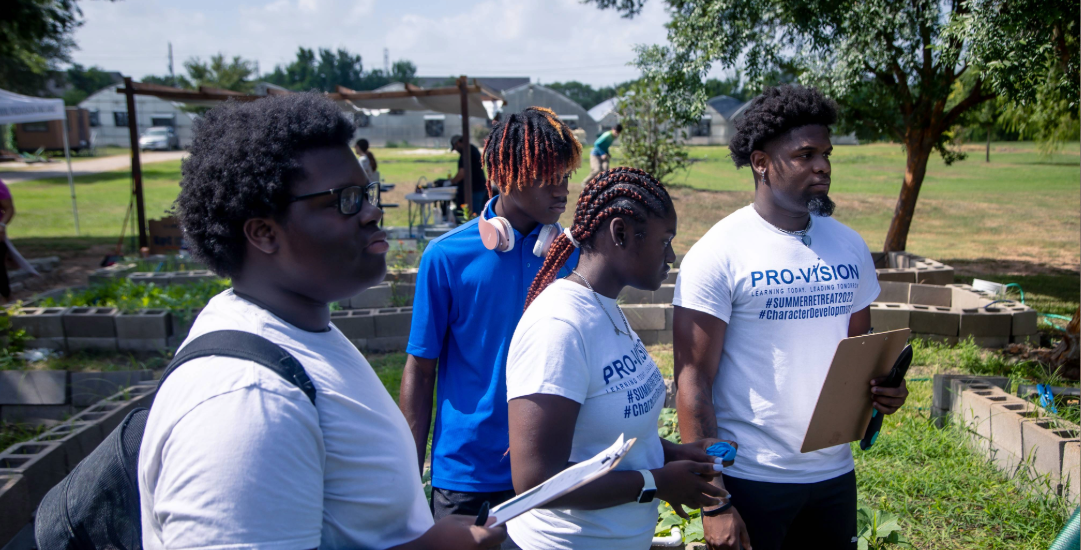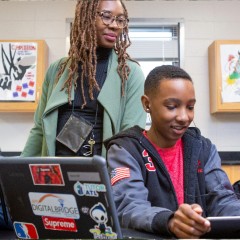Seeking Solutions is a special editorial series by the Kinder Institute's Urban Edge highlighting the people, organizations and initiatives bringing positive change to communities in the greater Houston region.
Upon retiring and relocating to Houston, he began working as an insurance salesman — a venture that would prove to be short-lived. Young, now commonly referred to as “Coach Roy,” shifted his career aspirations to something he was more passionate about: serving as a mentor to young African American men. In 1990 he established Pro-Vision Inc. in the southeast Houston neighborhood of Sunnyside.
The nonprofit, which started as an all-male after-school program, has transformed over its three decades of operation into a coed initiative that seeks to end intergenerational poverty for its participants. It has served more than 7,000 people to date.
In 2024, the need for institutions like Pro-Vision in Houston is still pronounced. The most recent Kinder Houston Area Survey reported that 68% of Black respondents earn less than $50,000 a year, and only 22% of Black respondents reported having at least a bachelor’s degree.
The Urban Edge spoke with Diana Seifert, Pro-Vision’s chief operating officer, to discuss the organization’s past and present and the difficulties of overcoming intergenerational poverty. The interview has been edited for length and clarity.
Can you describe how a friendly wager led to the founding of Pro-Vision in 1990?
Our founder, Coach Roy, and his friend were driving around different neighborhoods that were identified as predominantly at-risk. They eventually found a playground where kids were playing basketball. One of the kids was like, “Hey, are you going to get off the court? Are you going to play? What are you doing here?” Coach Roy saw that as an opportunity to talk to the kids. He said, “Look, we’ll play, and if your team wins we’ll buy you all the pizza and soda you can have. If we win, we’ll still buy you the pizza, but you have to sit down for a minute and hear us out to talk about life and hear some advice.” Coach Roy and his friend won the game, and they bought the kids pizza, and they sat there and listened.
As the kids were leaving, one of them turned around and asked, “Are you going to be here next weekend?” They really hadn’t thought about that, but something in Roy said yes. When they came back the following weekend there were more kids. Before he knew it there were 75 kids. Coach Roy applied for 501(c)(3) status, and that’s how Pro-Vision came to be.
How would you describe the mission?
Our mission is to help young men and women through educational and social opportunities. We’re still doing what we did when we started, but where the vision has progressed is that our main, primary focus is through these efforts to help people get themselves out of poverty. If we can get them out of poverty, they can change their generational impact. It’s not just about impacting lives today, but impacting and transforming lives of tomorrow for the whole community.
Young people are pliable. As we get older, we become very set in our ways. The younger we get participants in the program and the longer we keep them, the more of an intergenerational impact that we can make.
Among Pro-Vision’s initiatives are the Job Enterprise Academy, Manhood Development, the Pro-Vision/McNair Urban Farm and the S.H.E. Program. What is the significance of these programs?
Education and character development have always been at the forefront of what we do. As the organization has evolved, our thought has been, let's give our participants a way to critically think themselves out of situations, and have a better education so they can be ahead of the game or get to the starting line, because our community predominantly falls behind the grade curve because of poverty.
Healthy eating is also very important. Our community is in a food desert. Coach Roy had done some research about how urban farming was impacting wealthy neighborhoods, and thought it could certainly help the impoverished.
Now we’re focusing on our housing initiative because we believe that in order to foster complete human development, you have to help them morally change character development, provide a quality education, offer access to healthy eating, and ensure they have a roof over their heads.
Can you elaborate on how housing fits into Pro-Vision’s work going forward?
We like to think of affordable housing as the final piece of the puzzle. There’s not a lot of affordable housing in the Sunnyside community, and almost every apartment complex is about 95% full, with waiting lists. Our goal is to help people learn to be homeowners and to care about their neighbors. Our community is very transient, and they don’t stay in one place for a long time. We want to teach them how to stay in one place for a long time, so that then they can build a home and build equity. The housing initiative is a multiphase plan to create a 400-unit community for mixed-income families, as well as single-family, multifamily, senior living, a community center and green space. Our goal is to start construction in the first quarter of 2024.
The housing initiative aims to thwart neighborhood gentrification. The Kinder Institute’s Re-Taking Stock report showed how gentrifying communities in Harris County and Houston have evolved over the past 20 years. Of the neighborhoods that are identified as experiencing gentrification, four are historically Black communities, including Sunnyside.
What are some of the typical challenges that Pro-Vision participants encounter?
Many of our participants are being raised in a single-parent home. Many of them are being raised by their grandmother. There are so many things that have changed in the dynamic of the family unit in the Sunnyside community. That makes it very difficult for them.
What we’ve realized is a lot of kids who have come through Pro-Vision were told at some point that they couldn’t receive a higher education. Many have dropped out of high school so that they could help their families financially. They don’t usually go back to school, and thus continues the cycle of poverty.
We started taking the students to local colleges and explained to them that there were opportunities to go to college. If you can visualize something, you can create it. It has been incredible to see the difference and the impact that had with students attending college after those visits. We have had many students graduate college and have very successful lives after that.
How can the Houston community assist Pro-Vision participants?
Of course, financial assistance is one way. We can always use financial resources for our participants, because our enhancement activities are supplemental, whether they are after school or on the weekends.
The other way, especially right now, is empathy. A lot of people see those in poverty and think that they know better. But until you’ve walked in their shoes and have experienced some of the things that they have, it’s very difficult to understand. A lot of people say, “They’re in poverty because they want to be in poverty.” No one wants to be in poverty.
That’s where we come in with the resources and the education to show them there is a path out of this, but you have to do the work. It’s simple, but it’s not easy. It’s simple because we can tell you what steps to take. It’s not easy, because it takes a lot of work, and there is no instant gratification.



